| Listing 1 - 10 of 66 | << page >> |
Sort by
|
Book
ISBN: 0198080360 Year: 2010 Publisher: New Delhi : Oxford University Press,
Abstract | Keywords | Export | Availability | Bookmark
 Loading...
Loading...Choose an application
- Reference Manager
- EndNote
- RefWorks (Direct export to RefWorks)
Book
ISBN: 9789353286422 Year: 2020 Publisher: Los Angeles : Sage,
Abstract | Keywords | Export | Availability | Bookmark
 Loading...
Loading...Choose an application
- Reference Manager
- EndNote
- RefWorks (Direct export to RefWorks)
This book presents the story of India's quest for renewed focus on the doctrine of nonalignment. It begins with a discussion on the evolution of India's foreign policy along with the origin of its most important pillar, nonalignment, and its cumulative effect in India and abroad. It further discusses challenges, compulsions and constraints for India's foreign policy in context of the current instability and insecurity due to mounting Chinese and Pakistani collusion against India's rising profile in Asia, the emerging Pyongyang-Beijing-Moscow axis against the US, the evolving US-China bipolar world order in the background of eastward shifting geopolitics, economic recession and terrorism. The book argues that it is incumbent upon India to take a fresh lead today to reinvent the doctrine not only for its own national interests but also for the entire Third World. It proposes various steps to revitalize India's foreign policy so that India can play a desired role in the present global order.
Book
ISBN: 9780199552023 0199552029 Year: 2011 Publisher: Oxford: Oxford university press,
Abstract | Keywords | Export | Availability | Bookmark
 Loading...
Loading...Choose an application
- Reference Manager
- EndNote
- RefWorks (Direct export to RefWorks)
India --- Foreign relations --- India - Foreign relations - 1984 --- -India - Foreign relations - 20th century
Book
ISBN: 8120709993 Year: 1989 Publisher: New Delhi Sterling Publishers
Abstract | Keywords | Export | Availability | Bookmark
 Loading...
Loading...Choose an application
- Reference Manager
- EndNote
- RefWorks (Direct export to RefWorks)
Book
ISBN: 9781849043045 Year: 2014 Publisher: London Hurst
Abstract | Keywords | Export | Availability | Bookmark
 Loading...
Loading...Choose an application
- Reference Manager
- EndNote
- RefWorks (Direct export to RefWorks)
Book
Year: 1992 Publisher: Washington : National Defense University Press,
Abstract | Keywords | Export | Availability | Bookmark
 Loading...
Loading...Choose an application
- Reference Manager
- EndNote
- RefWorks (Direct export to RefWorks)
Book
ISBN: 9781849048347 Year: 2017 Publisher: London : Hurst,
Abstract | Keywords | Export | Availability | Bookmark
 Loading...
Loading...Choose an application
- Reference Manager
- EndNote
- RefWorks (Direct export to RefWorks)
The archetype of 'my enemy's enemy is my friend', India's political and economic presence in Afghanistan is often viewed as a Machiavellian ploy aimed against Pakistan. The first of its kind, this book interrogates that simplistic yet powerful geopolitical narrative and asks what truly drives Indian's Afghanistan policy. Based on an extensive repertoire of hitherto untapped primary sources including official memoranda, diplomatic correspondence, and a series of interviews with key political actors, this book provides a comprehensive analysis of India's strategy debates and foreign policymaking processes vis-a-vis Afghanistan, from the last decade of the Cold War to the 1990s Afghan civil war and the more recent US-led war on terror. It demonstrates that Indian presence in Afghanistan has been guided primarily by an enduring vision for the region that requires a stable balance of power across the Durand Line. The author offers a nuanced understanding of India's strategic intent and actions, which is critical to resolving the seemingly unending war in Afghanistan, as well as wider bilateral disputes between the two South Asian rivals.

ISBN: 8170240840 Year: 1987 Publisher: New Delhi Ashish Pub. House
Abstract | Keywords | Export | Availability | Bookmark
 Loading...
Loading...Choose an application
- Reference Manager
- EndNote
- RefWorks (Direct export to RefWorks)
Book
ISBN: 9780198081746 019808174X Year: 2013 Publisher: New York (N.Y.): Oxford university press,
Abstract | Keywords | Export | Availability | Bookmark
 Loading...
Loading...Choose an application
- Reference Manager
- EndNote
- RefWorks (Direct export to RefWorks)
India --- Foreign relations --- Inde --- Relations extérieures --- India - Foreign relations - 1947-1984 --- India - Foreign relations - 1984 --- -Inde --- -India --- Relations extérieures
Book
ISBN: 9780198743538 019874353X Year: 2015 Publisher: Oxford: Oxford university press,
Abstract | Keywords | Export | Availability | Bookmark
 Loading...
Loading...Choose an application
- Reference Manager
- EndNote
- RefWorks (Direct export to RefWorks)
Following the end of the Cold War, the economic reforms in the early 1990s, and ensuing impressive growth rates, India has emerged as a leading voice in global affairs, particularly on international economic issues. Its domestic market is fast-growing and India is becoming increasingly important to global geo-strategic calculations, at a time when it has been outperforming many other growing economies, and is the only Asian country with the heft to counterbalance China. Indeed, so much is India defined internationally by its economic performance (and challenges) that other dimensions of its internal situation, notably relevant to security, and of its foreign policy have been relatively neglected in the existing literature. This handbook presents an innovative, high profile volume, providing an authoritative and accessible examination and critique of Indian foreign policy. The handbook brings together essays from a global team of leading experts in the field to provide a comprehensive study of the various dimensions of Indian foreign policy.
| Listing 1 - 10 of 66 | << page >> |
Sort by
|

 Search
Search Feedback
Feedback About UniCat
About UniCat  Help
Help News
News